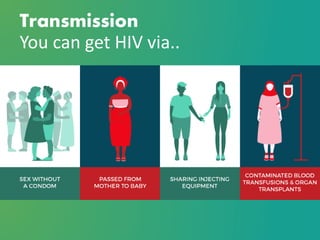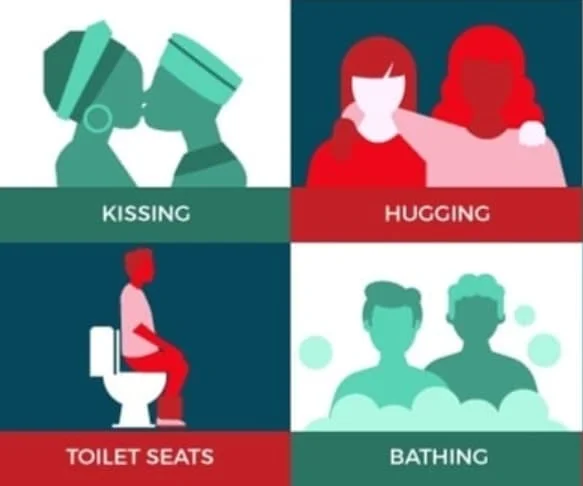Transmission of Hiv Occurs Through Which of the Following
Also included in this definition are medications derived from blood such as. Examples of less common routes of transmission include oral sex and transmission during.

The Human Immunodeficiency Virus Hiv
HIV transmission from mother to infant can occur antepartum in utero intrapartum during labor or delivery or postpartum through breast-feeding Report of a Consensus Workshop 1992.

. Indirect contact transmission occurs when there is no direct human-to-human contact. For transmission to occur the HIV in these fluids must get into the bloodstream of an HIV-negative person through a mucous membrane found in the rectum vagina mouth or tip of the penis. When we are talking about the transmission of HIV through sharing razors and sharing toothbrushes for that matter normally there is a low risk for HIV.
Mosquitoes because although these insects suck blood they do not regurgitate blood containing live HIV into the bodies of other victims. Even today over 40 years after its discovery HIV is. To assess the outcomes of efforts to prevent mother-to-child transmission MTCT of human immunodeficiency virus HIV made over the last 2 decades in New York State NYS through review of data from multiple sources.
The virus enters the body through the lining of the vagina vulva penis rectum or mouth during sexual activity. These things include blood and tissuemucous membranes. HIV-2 occurs primarily in West Africa.
Sharing baths towels or cutlery. By mosquitoes ticks or other insects. HIV is most commonly transmitted through anal and vaginal sex and the sharing of drug injection equipment.
Using available surveillance laboratory and program monitoring data the following were examined for NYS. HIV passes between people through blood and certain other body fluids including semen pre-seminal fluid rectal fluids vaginal fluids and breast milk. The exact mechanism of mother-to-child transmission of HIV remains unknown.
Available data suggest that at most 25 to 30 of perinatal HIV transmission occurs in utero Rogers et al 1989. Transmission of HIV occurs through which of the following. By hugging shaking hands sharing toilets sharing dishes or closed-mouth or social kissing with someone who has HIV.
Unprotected sexual intercourse with someone with HIV needle-sharing among drugs users often leads to HIV transmission because. Sharing cutlery plates or cups because HIV cannot be transmitted in saliva. Today we have a solid scientific understanding of HIV transmission.
Sexual contact - HIV is spread most commonly by sexual contact with an infected partner. 1 the rate of prenatal. Transmission may occur during intrauterine life delivery or breastfeeding.
HIV transmission only occurs if the bodily fluids of a person with detectable levels of HIV enter the bloodstream of a person who does not have HIV. Human immunodeficiency virus HIV is a human retrovirus with two identified types HIV-1 and HIV-2. In infants HIV invasion in the upper gastrointestinal tract occurs after exposure to or ingestion of infected maternal blood and genital secretions during birth as well as infected milk during breast feeding.
Through cuts and sores in the skin. Contact occurs from a reservoir to contaminated surfaces or objects or to vectors such as mosquitoes flies mites fleas ticks rodents or. Most people who get HIV get it through anal or vaginal sex or sharing needles syringes or other drug injection equipment for example cookers.
Semen cum and pre-seminal fluid. Through the thin lining on or inside the anus vagina and genitals. Open cuts or sores.
HIV can enter the bloodstream through. Contact with unbroken healthy skin. Or by direct injection.
An HIV-positive person can transmit the virus to the child through breastfeeding childbirth or pregnancy. How Is HIVAIDS Transmitted. Up to 24 cash back Transmission of HIV occurs through the exposure of several things.
Through the thin lining of the mouth and eyes. Dual infection with both. HIV resides in bodily fluids such as semen blood or even breast milk.
Direct contact transmission occurs when there is physical contact between an infected person and a susceptible person. However HIV is not transmitted through urine sweat tears or saliva. The most common forms of exposure are through sexual practices or through the blood.
We know that HIV can only be transmitted in very limited circumstances such as. HIV does not survive long outside the human body such as on surfaces and it cannot reproduce outside a human host. HIV-1 is the most widely prevalent type and is the cause of the global HIV pandemic.
Luzuriaga et al 1993. For transmission to occur HIV present in these fluids must get into the bloodstream through a mucous membrane found in the rectum vagina penis and mouth open cuts or sores or by direct injection. However due to the screening of blood for evidence of HIV.
The possibility that some previously unrecognized route of HIV transmission might exist or could occur in the future can never be entirely excluded. Infant gut mucosal surfaces are the most likely site at which transmission occurs. An HIV-positive mother can transmit HIV to her baby any time during pregnancy childbirth or breastfeeding.
Blood contamination - HIV may also be spread through contact with infected blood. In adults transmission in the upper gastrointestinal tract occurs following contact with HIV-containing semen during fellatio but the efficiency of this route is low. HIV-1 has been detected in breast milk in cell-free and cellular compartments.
Using the same toilets or swimming pools. HIV is not passed on through. Bloodborne pathogens such as HBV HCV and HIV can be transmitted through contact with infected human blood and other potentially infectious materials OPIM as defined below.
Transmission through breast-feeding can take place at any point during lactation and the cumulative probability of acquisition of infection increases with duration of breast-feeding. Through saliva tears or sweat. This is because the HIV virus dies very.
If you are a woman with HIV and you are pregnant treatment with a combination of HIV medicines called antiretroviral therapy or ART can prevent transmission of HIV to your baby and protect your health. Transmission of HIV can occur during sexual contact through parenteral exposure to blood and blood products and from mother to child during the perinatal period. It is not transmitted.
Blood is defined as human blood human blood components and products made from human blood. But there are powerful tools that can help prevent HIV transmission. Ehrnst et al 1991.
Social contact with people with HIV because HIV is not transmitted by touch or through the air.


No comments for "Transmission of Hiv Occurs Through Which of the Following"
Post a Comment